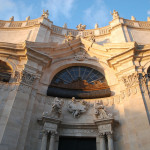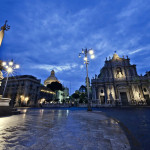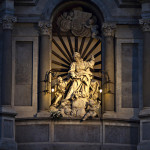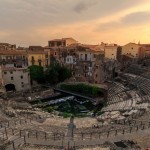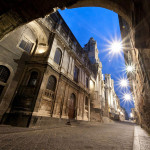Around Catania
- Intermediate
Ready to discover Catania, the black city at the foot of the majestic volcano Etna and a crossroads of cultures? Thanks to special card Catania Pass, you will have access to free or with a discounted price to museums, unlimited use of urban public transport vehicles (including fast line Alibus Airport – Center and the Metropolitan line of the Circumetnea Railway) and get special discounts at shops, restaurants and contracted activities!
Get lost in the baroque downtown streets, discover the landscapes full of color, savor the true cuisine and breathe the smell of the sea, admiring palaces Liberty, baroque architecture, greek-Roman and Norman, markets and rionali ammirane the charm!
How much is the Catania pass? for one person, € 12,50 for a day; 16,50 € for 3 days; 20 euro for 5 days. For a family of two adults with one or two children under the age of 13, it costs 23 Euros for a day; 30,50 € for 3 days; and 38 euro for 5 days.
St. Agatha Abbey
Next to the Cathedral, overlooking Via Vittorio Emanuele there is the St. Aghata’s Abbey. The Abbey was completed in 1735 and some critics think that this building is the architect Vaccarini’s masterpiece. A jewel realized in Sicilian baroque style.
Visit the terraces of the Abbey to admire the city in a different way.
Piazza Duomo
It’s the main square in Catania; via Etnea, Via Vittorio Emanuele and Via Garibaldi, the three main roads of the old town, cross in this place. It is surrounded by many monuments and in its centre is placed the famous “Elephant’s fontain”, built by Gianbattista Vaccarini.
To admire the square and its monuments, sit at one of the historic bar where you can taste the local cuisine.
Saint Agatha’s Cathedral (Duomo)
Saint Agatha’s Cathedral takes its name from the “Santuzza” protector of the city, her feast day is on February 5th. With its massive structure, the Cathedral has the characteristic contrast between the gray and white marble it’s used for the decorations.
Diocesan Museum
The Diocesan Museum is located in the east ala of the Clerics’ seminary next to the Cathedral, preserves Diocese of Catania’s collection of liturgical furnishings. By type, furniture and objects are stored inside dating from several historical periods ranging from 1300 onwards.
Worth a visit the panoramic balcony.
Palazzo Biscari
Along via Dusmet, not far from the “Pescheria”, it’s located the Palazzo Biscari, which takes its name from the Biscari principles who lived there. The palace has several rooms in rococo style, full of frescoes and decorations. Today its museum hosts MF “Museum&Fashion”.
Bellini Museum
In the eighteenth-century Cruyllas Gravina’s palace, it’s the birthplace of the composer Vincenzo Bellini, it was declared national monument in 1923. A historical path to investigate the most intimate Bellini’s life aspects, through the objects and relics that belonged to the famous composer,
A time course to investigate the most intimate aspects of Bellini's life.
Roman theatre and Odeon
Between via Teatro Greco and via Vittorio Emanuele there are the Roman Theatre and the Odeon. Some people assumed that their building dates back to II sec. AD, and that the theatre was carried out on a pre-existing Greek Age structure.
It is one of the few places in Catania where you can see Amenano river.
Ursino Castle
Between 1239 and 1250, Frederick II ordered to build the Ursino Castle for defensive purpose of the East coast of Sicily and it was on a promontory surrounded by sea. In 1669, the eruption gets the Castle away from the sea.
The museum often houses temporary exhibitions and events that melt with the permanent one. To be visited.
Benedictine Monastery
It’s a “jewel” of the late Sicilian Baroque architecture and an example of integration among different periods, it is shown in UNESCO’s World Heritage Site. From 1977, the plezus monastic houses the Humanities faculty.
Via Crociferi
Via Crociferi is one of the oldest Catania streets in the heart of the city, it starts in Piazza San Francesco D’Assisi through the famous St. Benedict triumphal arch. It is considered the symbol of Baroque in Catania, because there are some of the most beautiful eighteenth-century churches of the city.
